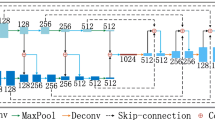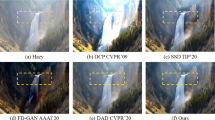Abstract
Infrared (IR) imaging, an import method of target monitoring, suffers great imaging quality degradation in poor weather conditions such as haze, fog, and smog. This will greatly affect the ability of detecting and identifying for targets with far distance. For visible-light imaging, an image processing technique named dehazing has been developed in the past several years. However, these dehazing methods for visible light can hardly be used to IR picture dehazing directly, due to the natural difference between IR and visible-light images. In this paper, an IR image dehazing algorithm based on multiple-factor fusion cascade network (MFFCN) is proposed, which includes multi-patch image encoder, multi-channel feature enhancement module and multi-level feature fusion module to directly remove the haze. Specifically, a multi-patch image encoder aggregating features from multiple patches of image to improve the response for different levels of haze in different regions and a multi-channel feature enhancement module can provide interactions of cross-feature and enrich the diversity of learned representations. A multi-level feature fusion module is integrated to calculate the importance weights of different network levels, and then, the calculated weights are utilized to fuse the corresponding feature. The experimental results showed that our MFFCN achieves the highest performance with both visual perception and evaluation metric, when compared with previous state-of-the-art methods. Particularly, for thick hazing scene, a greatly contrast enhancement for the local area around target has been achieved. In addition, the effectiveness for ground background image hazing and halation removing is demonstrated, which can also obtain superior performance.





Similar content being viewed by others
References
Zhou F, Yiquan W, Dai Y, Ni K (2020) Robust infrared small target detection via jointly sparse constraint of l1/2-metric and dual-graph regularization. Remote Sens 12(12):1963. https://doi.org/10.3390/rs12121963
Zhang Y, Wang X, Bi X et al (2018) A light dual-task neural network for haze removal. IEEE Signal Process Lett 25(8):1231–1235
He K, Sun J, Tang X (2010) Single image haze removal using dark channel prior. IEEE Trans Pattern Anal Mach Intell 33(12):2341–2353
Fattal R (2014) Dehazing using color-lines. ACM Trans Graph (TOG) 34(1):1–14
Berman D, Avidan S et al (2016) Non-local image dehazing. In: Proceedings of the IEEE conference on computer vision and pattern recognition, pp 1674–1682
Meng G, Wang Y, Duan,J, Xiang S, Pan C (2013) Efficient image dehazing with boundary constraint and contextual regularization. Proceedings of the IEEE international conference on computer vision pp. 617–624, IEEE
Pei SC, Lee TY (2012) Nighttime haze removal using color transfer preprocessing and dark channel prior. In: 2012 19th IEEE International conference on image processing, pp 957–960, IEEE
Gated context aggregation network for image dehazing and deraining. In: 2019 IEEE winter conference on applications of computer vision (WACV), IEEE, pp 1375–1383
Ancuti CO, Ancuti C (2013) Single image dehazing by multi-scale fusion. IEEE Trans Image Process 22(8):3271–3282
Cai B, Xu X, Jia K, Qing C, Tao D (2016) Dehazenet: an end-to-end system for single image haze removal. IEEE Trans Image Process 25(11):5187–5198. https://doi.org/10.1109/TIP.2016.2598681
Li B, Peng X, Wang Z, Xu J, Feng D (2017) Aod-net: all-in-one dehazing network. In: Proceedings of the IEEE international conference on computer vision, pp 4770–4778
Song Y, Li J, Wang X et al (2017) Single image dehazing using ranking convolutional neural network. IEEE Trans Multimedia 20(6):1548–1560
Das SD, Dutta S (2020a) Fast deep multi-patch hierarchical network for nonhomogeneous image dehazing. In: Proceedings of the IEEE/CVF Conference on Computer Vision and Pattern Recognition Workshops, pp 482–483, IEEE
Zhang H, Wu C, Zhang Z, et al (2020) Resnest: Split-attention networks. arXiv preprint arXiv:200408955
Xie B, Guo F, Cai Z (2010) Improved single image dehazing using dark channel prior and multi-scale retinex. In: 2010 international conference on intelligent system design and engineering application, IEEE, pp 848–851, IEEE
Catch CQ (2020) Retinex theory
Xu H, Guo J, Liu Q, et al (2012) Fast image dehazing using improved dark channel prior. In: 2012 IEEE international conference on information science and technology, pp 663–667, IEEE
Liu X, Ma Y, Shi Z, et al (2019) Griddehazenet: Attention-based multi-scale network for image dehazing. In: Proceedings of the IEEE/CVF International Conference on Computer Vision, pp 7314–7323, IEEE
Shao Y, Li L, Ren W, et al (2020) Domain adaptation for image dehazing. In: Proceedings of the IEEE/CVF conference on computer vision and pattern recognition, pp 2808–2817
Fan Q, Chen D, Yuan L et al (2019) A general decoupled learning framework for parameterized image operators. IEEE Trans Pattern Anal Mach Intell 43(1):33–47
Fan Q, Chen D, Yuan L, et al (2017) A generic deep architecture for single image reflection removal and image smoothing. In: Proceedings of the IEEE/CVF International Conference on Computer Vision, pp 3258–3267
Das SD, Dutta S (2020a) Fast deep multi-patch hierarchical network for nonhomogeneous image dehazing. In: Proceedings of the IEEE/CVF Conference on Computer Vision and Pattern Recognition Workshops, pp 482–483
Zhang H, Patel VM (2018) Densely connected pyramid dehazing network. In: Proceedings of the IEEE conference on computer vision and pattern recognition, pp 3194–3203
Yu F, Koltun V (2015) Multi-scale context aggregation by dilated convolutions. arXiv preprint arXiv:151107122
Wang Z, Ji S (2021) Smoothed dilated convolutions for improved dense prediction. Data Min Knowl Disc 35(4):1470–1496
Ulyanov D, Vedaldi A, Lempitsky V (2016) Instance normalization: The missing ingredient for fast stylization. arXiv preprint arXiv:160708022
Li B, Ren W, Fu D, et al (2017b) Reside: a benchmark for single image dehazing. arXiv preprint arXiv:171204143 1
Deperlioglu O, Kose U (2015) Underwater image enhancement with dark channel prior based image dehazing and histogram equalization. arXiv preprint arXiv:171204143
Nawaz, M., Raja, G., Qasim, M. (2021). A new approach for dehazing and enhancement of infrared images. In: 2021 international Bhurban conference on applied sciences and technologies (ibcast), pp 545–551
Author information
Authors and Affiliations
Corresponding author
Ethics declarations
Conflict of interest
The authors declare that they have no conflict of interest.
Additional information
Publisher's Note
Springer Nature remains neutral with regard to jurisdictional claims in published maps and institutional affiliations.
Rights and permissions
About this article
Cite this article
Gao, X., Tang, P., Cheng, Q. et al. Air infrared small target local dehazing based on multiple-factor fusion cascade network. Neural Comput & Applic 35, 8657–8665 (2023). https://doi.org/10.1007/s00521-022-07553-2
Received:
Accepted:
Published:
Issue Date:
DOI: https://doi.org/10.1007/s00521-022-07553-2




